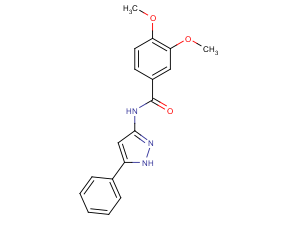
JK-P3
CAS No. 942655-44-9
JK-P3( 3,4-Dimethoxy-N-(5-phenyl-1H-pyrazol-3-yl)-benzamide )
Catalog No. M17680 CAS No. 942655-44-9
JK-P3 is a pyrazole-based inhibitor of VEGFR-2 (IC50: 7.8 μM). JK-P3 inhibits FGFR 1/3 kinase activity in vitro, but has no effect on FGFR signaling in cell-based assays.
Purity : >98% (HPLC)
 COA
COA
 Datasheet
Datasheet
 HNMR
HNMR
 HPLC
HPLC
 MSDS
MSDS
 Handing Instructions
Handing Instructions
| Size | Price / USD | Stock | Quantity |
| 5MG | 50 | In Stock |


|
| 10MG | 88 | In Stock |


|
| 25MG | 200 | In Stock |


|
| 50MG | 357 | In Stock |


|
| 100MG | 530 | In Stock |


|
| 200MG | Get Quote | In Stock |


|
| 500MG | Get Quote | In Stock |


|
| 1G | Get Quote | In Stock |


|
Biological Information
-
Product NameJK-P3
-
NoteResearch use only, not for human use.
-
Brief DescriptionJK-P3 is a pyrazole-based inhibitor of VEGFR-2 (IC50: 7.8 μM). JK-P3 inhibits FGFR 1/3 kinase activity in vitro, but has no effect on FGFR signaling in cell-based assays.
-
DescriptionJK-P3 is novel inhibitor of VEGFR-2. JK-P3 is a pyrazole-based inhibitor of VEGFR-2 (IC50 = 7.8 μM). JK-P3 inhibits FGFR 1/3 kinase activity in vitro, but has no effect on FGFR signaling in cell-based assays. The compound blocks wound healing and tube formation in HUVEC without effecting endothelial cell proliferation.
-
In VitroJK-P3 (0.01-10 μM; 1 hour) inhibits VEGF-A-mediated VEGFR2 phosphorylation and downstream signalling.JK-P3 (0.01-10 μM; 16 hours) dose not inhibit HUVEC cell proliferation at 0.01~1 μM, and shows slight inhibitory activity at 10 μM.JK-P3 (1 and 10 μM; 1 hour) does not significantly inhibit VEGF-A-stimulated endothelial tube formation at 1 μM, but almost completely inhibits the ability of endothelial cells to form into elongated hollow tubes in the presence of VEGF-A at 10 μM. Western Blot Analysis Cell Line:Primary endothelial cells (treated for 7.5 min with 25 ng/mL VEGF-A)Concentration:0.01, 0.1, 1 and 10 μM Incubation Time:1 hour Result:Almost completely inhibited VEGFR2 Y1175 phosphorylation, also inhibited VEGF-A-stimulated PLCγ1, Akt and ERK1/2 phosphorylation.Cell Proliferation Assay Cell Line:HUVEC Concentration:0.01, 0.1, 1 and 10 μM Incubation Time:16 hours Result:Failed to inhibit endothelial cell proliferation at 0.01~1 μM but elicited a small but significant increase in cell proliferation at certain lower concentrations.
-
In Vivo——
-
Synonyms3,4-Dimethoxy-N-(5-phenyl-1H-pyrazol-3-yl)-benzamide
-
PathwayOthers
-
TargetOther Targets
-
RecptorVEGFR2
-
Research Area——
-
Indication——
Chemical Information
-
CAS Number942655-44-9
-
Formula Weight323.35
-
Molecular FormulaC18H17N3O3
-
Purity>98% (HPLC)
-
SolubilityIn Vitro:?DMSO : 50 mg/mL (154.63 mM)
-
SMILESCOc1c(cc(cc1)C(=O)Nc1n[nH]c(c1)c1ccccc1)OC
-
Chemical Name3,4-Dimethoxy-N-(5-phenyl-1H-pyrazol-3-yl)-benzamide
Shipping & Storage Information
-
Storage(-20℃)
-
ShippingWith Ice Pack
-
Stability≥ 2 years
Reference
1. Antony M. Latham, et al. Identification of Receptor Tyrosine Kinase Inhibitors Using Cell Surface Biotinylation and Affinity Isolation. VEGF Signaling pp 121-131 Cite as
molnova catalog



related products
-
cemadotin free base
Cemadotin free base(LU103793 free base) is a novel anti-limiting peptide , an analog of Dolastatin 15, a naturally occurring cytotoxic peptide that blocks mitosis and inhibits microtubules (tubulin) with a Ki of 1 μM. Cemadotin is used in research against cancer.
-
4-Hydroxy-3-nitrophe...
It is a small molecular drug, active to Ig heavy chain V-I region and Ig gamma-2 chain C region.
-
Angiogenin 108-122
Angiogenin (108-122) is an angiogenin peptide. Angiogenin (108-122) acts as a therapeutic agent for the prophylaxis and/or treatment of cancer, an infectious disease, a fibrotic disease, an inflammatory disease, a neurodegenerative disease, an autoimmune disease, or a heart and vascular disease.



 Cart
Cart
 sales@molnova.com
sales@molnova.com


